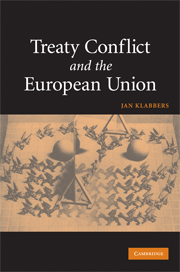Book contents
4 - Drafting the Vienna Convention
Published online by Cambridge University Press: 03 February 2010
Summary
Introduction
As Grotius and Vattel already foreshadowed, by treating conflicting commitments partly under the heading of interpretation, there are various possible ways of classifying, categorising, addressing or ignoring problems related to conflicting treaty norms. The 1969 Vienna Convention on the Law of Treaties devotes four or five articles to the topic (depending on how one counts) and, as if to underline the topic's messiness, those articles are scattered across the Convention. The main article is article 30, contained in the section on Application of Treaties. Article 41, included in the section on amendment and modification, deals with a modification of an existing treaty between some of the parties to that treaty and, needless to say, such a modification may come to affect the legal position of the remaining original parties (those who do not participate in the modification). Those two are, arguably, the most relevant provisions for present purposes, and will be central to the rest of this chapter.
Additionally, article 58 opens the possibility that parties suspend the operation of a treaty between some of them; again, the legal position of the original parties may be affected. Article 59, like article 58 included in the section on Invalidity, Termination and Suspension, recognises the possibility of concluding a treaty to abrogate an earlier one. And then there is article 31, paragraph 3(c), in the section on Interpretation, which holds that interpretation shall take into account ‘any relevant rules of international law applicable in the relations between the parties’. And those relevant rules, of course, may well be earlier treaty rules, or perhaps rules included in treaties with different parties.
- Type
- Chapter
- Information
- Treaty Conflict and the European Union , pp. 69 - 87Publisher: Cambridge University PressPrint publication year: 2008



